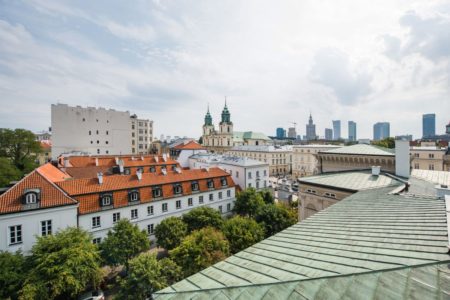The University of Warsaw has its seat in the capital of Poland, one of the most dynamically-developing cities in Europe. Warsaw is steadily climbing the international rankings of the world’s most attractive urban areas. Not only is Warsaw a political, economic, social and cultural centre, it is also an undisputed leader in Polish higher education and science. According to QS Best Student Cities 2019, Warsaw is 51st best city in the world. It receives a very high score in the affordability category – within the top five of the entire index – thanks to its combination of low living costs and reasonable tuition fees.
Warsaw – facts and figures
| Area | Facts |
| history: | the capital of Poland since 1596 |
| location: | Central Poland (Masovian Voivodeship) |
| population: | 1.7 milion inhabitants |
| area: | 517 km2 |
| districts: | 18 |
| academic life | 15 public Higher Education Institutions, 240,000 students |
- 8.3 million tourists per year
- 120 hotels and youth hostels
- 175 cinemas, theatres, music venues, museums, art galleries
- 80 parks
- 270 bus and tram lines, 2 metro lines, 4 SKM lines (Urban Rapid Rail)
- 450 kilometres of cycle paths
Official websites and social media of Warsaw and recommended links
- City of Warsaw
- YouTube
- Tourist Portal of Warsaw
- Study in Warsaw
- Public transport in Warsaw
- Veturilo – city bikes
- Route Planner
- Monthly Magazine “Warsaw Insider”
Maps of Warsaw
- Plan of Warsaw (Historical Map, Warsaw Today, Cycling)
- UW in Warsaw (PDF File)
Living costs
- Rent in a student residence hall: EUR 80-150
- Rent in a shared flat: from EUR 200
- Rent in a studio: from EUR 400
- Transportation: monthly pass for all means of transport in Warsaw: full fare – EUR 27 (110 PLN), reduced (for students) – EUR 14 euro (55 PLN)
- Food: EUR 150
- Phone / internet: EUR 20-30
- Leisure / entertainment: EUR 50-100
- Lunch in a mid-range restaurant: from EUR 7
- Coffee in a café: from 2 EUR
- Theatre ticket: EUR 7-24
- Cinema ticket: EUR 3-7
- Museum ticket: EUR 4-10
Transportation
Cultural, Sports & Tourist Activities
Cultural institutions and sports facilities in Warsaw
- 70 museums
- 40 art galleries
- 25 cinemas
- 40 theatres and music institutions
- 200 libraries
- 2000 monuments
- 80 parks
- 450 kilometres of cycle paths
- 250 sports clubs
- 6 city beaches along the Vistula river
Recommended links, guidebooks, brochures
- Tourist Portal of Warsaw
- Veturilo – city bikes
- Monthly Magazine “Warsaw Insider”
- Warsaw City Tour Guide
- Warsaw Top 10
- Warsaw Top Museums
- Chopin’s Warsaw
- Warsaw for active people
- Map of Warsaw for tourists
- Other official brochures for tourists
Calendar of major cultural and sports events in Warsaw
| Month | Event |
| March | |
| April | |
| May | |
| June | |
| September | |
| October | |
| December |







